BY LETTER
Resonance (TRAPPIST-1) System: History
Galactography > Regions of Space > Inner Sphere
Galactography > Systems and Worlds > Systems & Worlds Q - R
Galactography > Systems and Worlds > Systems & Worlds Q - R
Events in the Resonance system, also known as the Seven Marbles, TRAPPIST-1 | |
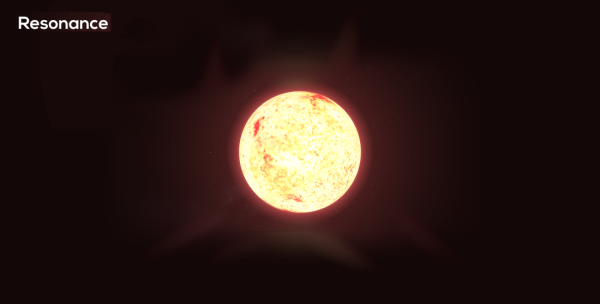 Image from The Astronomer | |
| Resonance (Trappist-1) | |
Overview
The Resonance (Seven Marbles) system (TRAPPIST-1) includes seven terrestrial planets linked by a resonance chain, orbiting the red dwarf star Resonance. These planets are Senrau, Visne (originally known as Rasante), Reyvik, Remi (originally known as Fulno), Shinoh (originally known as Eunna), Nene (originally known as Matow) and Yaudel. Outside these planets is a large but relatively sparse asteroid belt, with its focus at Samsara.See this article which describes the condition of this system when the first colony ship arrived in 865 AT.
The system is currently part of the Iota Network, an independent polity lead by the archailect Iota Scholar, with close ties to various other polities such as the NoCoZo and Solar Dominion. The network is centered in the Lucida (Iota Piscium) system and includes a variety of star systems within the Inner Sphere.
Introduction
The Seven Marbles system consists of a natural planetary resonance chain, with 7 worlds in a harmonic relationship, hence its name. It was colonised by several groups from various stars, resulting in a large number of polities with different, often radically different cultures. This system has a long history of internal differences, sometimes simply ideological differences and other times full-scale military conflicts, most notably the First Resonantine War in 3331 AT.A Brief Timeline of the Resonance System | |
| 865 | The first colony ship The Maid arrived. Due to cryogenic failure, the colonists in hibernation died en route, and with no cryosleep facilities available the crew all died of old age before reaching TRAPPIST-1, but the fully sophont ship The Maid began to create a population of aioid and vec offspring by replicating itself in a diverse range of forms. The Maid renamed the TRAPPIST-1 system and star Resonance. |
|---|---|
| 1022 | Descendants of The Maid began to colonise Reyvik. |
| 1055 | First communication between the Federation of Sophonts in Solsys and the Resonance system. |
| 1076 | Descendants of The Maid began to colonise Senrau. |
| 1106 | Descendants of The Maid began to colonise Rasante, which later became known as Visne. |
| 1212 | Descendants of The Maid began to colonise Fulno, which later became known as Remi. |
| 1220 | A Federation explorer ship Songs of Worlds arrived at Resonance. |
| 1298 | A Beamrider ship arrived in the system, and began to set up a boostbeam station, thus opening up the system to new colonists. A significant fraction of Maids left the system, but many remained and diversified even further. |
| 1408 | Resonance joined the Federation, and a Federation Representative arrived. Federation influence on the Resonance system was relatively minimal. |
| 2139 | News of the dissolution of the Federation of Sophonts reached Resonance, and the FedRep returned to Solsys. |
| 2185 | The disparate factions on the dayside and nightside of Fulno became unified as the DayNight Union, and renamed their world Remi. |
| 2298 | Missionaries from the Conver Ambi arrived and set up a polity on Yaudel; this became known as the Sekintorof Cyborgium. |
| 2890 | A wormhole link to Lucida arrived, strengthening ties to the Taurus Nexus. The DayNight Union and the Republic of Eunna became aligned with the Taurus Nexus. After joining the Taurus Nexus, new factions were drawn towards the system. Improved communication links provided the system with new technologies, interstellar partnerships, and cooperation, but it also cursed the system with many rival groups with incompatible goals. |
| 3300 | The Samsara Focus proposed that the Resonance System could benefit from a common policy under a formal league of worlds. However this proposal failed due to resistance from many quarters. |
| 3300s | This period was marked by the divisions between the numerous factions in the Resonance system. The Sekintorof Cyborgium, and the Rasante Empire were expansionist and were competing for the top spot within the inner system, fighting over territories and assets and generally trying to sabotage and undermine the growth of each other. The DayNight Union and the Republic of Eunna were sympathetic with Corona, and these became allied since the Samsara Focus' failed unification campaign. These two polities were weak when alone, but were quite formidable together. |
| 3331 | Corona announced that it is sending a fleet to Resonance, to revive the crumbling influence of the Taurus Nexus. Already the Coronese had sent a very large number of freighters through the wormhole, which were actually disguised warships; this caused the Wormhole controller to collapse the wormhole down to non-traversable size, an action repeated throughout the Terragen Sphere whenever interstellar warfare looms large. This event caused the start of the First Resonantine War, with the Sekintorof faction attacking Taurus Nexus warships and other non-weaponised freighters throughout the system. At the same time the Rasante Empire sent an expeditionary force to Reyik, which was already largely under its influence, to suppress various subversive elements. However the Revolutionary Forces on Reyvik had the backing of the Enneteers' Rebellion, so resistance was considerable. The DayNight Union and the Republic of Eunna, fearing that the Rasante and the Sekintorof would try to ideologically unify the system, reluctantly joined the conflict, and initially suffered massive losses which led to the fall of the Day-Night Union, but the Eunnans eventually allied itself with the Rasante to crush the Sekintorof, once and for all. When the Sekintorof were crushed, the victors attempted to purge the system of Conver Ambi memetics, with some success. A number of other factions then joined the war, such as a range of independent orbital nations, the Revolutionary Forces on Reyvik and the Enneteers' Rebellion, mostly opposed to the Rasante Empire. |
| 3341 | After another decade of chaotic and bloody conflict these groups allied with Eunna to attack Rasante. The following local technocalypse, commonly referred to as the Seven Marbles Fallapart, destroyed whatever ruling structure that survived the bloody conflict and nearly ended civilisation in the entire system. |
| 3355 | The Corona Fleet finally arrived in 3355, and with their assistance the system was pacified and gradually restored. Eunna lost much of its population to emigration, to Matow and Yosunoh (Iota Pegasi). |
| 4077 | The entire population of Yaudel announced plans to transcend directly to S:3 status, but were dissuaded from this risky procedure by the rest of the system. |
| 4790 | An unexpected technoswarm event on Eunna caused devastation. The source of this swarm remains unknown, although conspiracy theories abound. Several years of disorder followed, generally known as the Second Resonantine War. |
| 4799 | At the end of the Second Resonantine War a transapient blight depopulated Senrau. The blight destroyed itself but Senrau became isolationist as a result. |
| 5411 | The Iota Network, based in the Lucida (Iota Piscium) system and associated transapient advisers, arrived in Resonance and peacefully took control over the system, citing the ideological tension period that followed the decline of the ComEmp as the reason. |
| 7866 | A number of computronium nodes were constructed on Yaudel's seafloor, using the ocean as a heat sink; these nodes host a diverse range of virchworlds. |
| 8876 | The Seven Marbles Combine formed under the guidance of the S:2 transapient The Scholar, including most of the planets in this system and many of the orbiting habitats. |
| 10003 | The transapient Scholar ascended peacefully to S:3, and moved somewhat closer in philosophy to the Keter Dominion, perhaps due to the relative proximity of Ain Soph Aur. |
In the Current Era, Seven Marbles, together with Iota Piscium and Yosunoh (Iota Pegasi), form the core members of the present-day Iota Network. The cultures of these seven worlds and of the innumerable orbiting habitats in the system have evolved significantly in recent millenia while each retaining their own iconic style, fostering interplanetary contact and tourism. Seven Marbles' Hohmann regattas are one of the most popular sports events in the Inner Sphere.
The Resonance System - world by world
Resonance (TRAPPIST-1)
Resonance is a late M-type main sequence star at the center of the Seven Marbles system. In its natural state, it was prone to emit flares, which rendered the inner system hostile to habitation. Despite this a significant fraction of the population, mostly embodied AIs, made their homes on the inner worlds, mostly on the dark sides. The star was eventually stabilized in 5688 and has since been converted into a computation node for the local transapient, the Scholar. Currently a constellation of ISOs circle the star in close proximity, hosting both Scholar subminds and subordinate entities.See this article for more details about the star Resonance, and its physical characteristics before colonisation.
Senrau (TRAPPIST-1b)
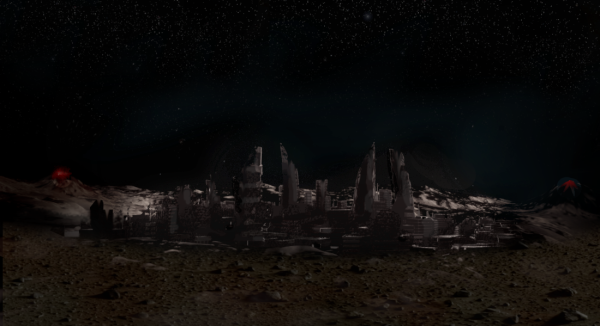 Image from Steve Bowers | |
| On the dark side of Senrau are several ancient ruined vec cities, illuminated only by aurorae and the glow from tidally-induced volcanic events. | |
Name meaning: Senja came from Visnean word for 'clear sky', since this world had lost almost all of its primordial atmosphere.
Colonised: 1076 by descendants of The Maid.
At first Senrau was only inhabited by a small population of vecs and aioids, mostly descendants of The Maid. Most of these inhabited the dark side, protected from the flares. They built photovoltaic arrays on the starward side to collect power, but these were prone to damage during outbursts.
At the end of the Second Resonantine War in 4799, the autonomous defence system mutated into a S:1 transapient blight which eventually destroyed itself, but took down a good chunk of the world's population and infrastructure with it. A recontact and rescue expedition several hundred years later discovered a xenophobic culture, leading to the decision to leave them alone. The xenophobic mindset eventually declined, probably due to subtle memetic influence from outside; gradually contact between the world and the rest of the system recommenced.
Since joining the Seven Marbles Combine in 9378, Senrau has been gradually developing, though it still only has a fraction of the population of the next least populous planet, Visne. Power collection arrays on the dayside supply power to the mining complexes, which extract resources for use in the ISO belt around Resonance.
The dark side supports a network of infrastructure, which hosts a range of virtual reality environments, mostly historical or alternate-reality-based. Senrau's dark age cultures are effectively extinct, though they are recreated in many of the planet's virches. The planet is famous for its gloomy, ruined, ancient vec cities on the dark side, which are popular tourist destinations, and as a waypoint on the Hohmann regatta races.
See this article for more details about the world Senrau, and its physical characteristics before colonisation.
Visne (TRAPPIST-1c)
 Image from Steve Bowers | |
| The Visne Hoop is a habitat on the Dark Side of Visne, illuminated by solar power collector arrays on the daylit side. The habitat maintains an Earth-like day-night cycle and environment. At the centre of the darkside, several volatile extraction stations are visible. | |
This world was originally named Rasante by the first colonists.
Names: Rasante (Rasan), Visne
Name meaning: Rasante, the original name, signifies harmony. The world was renamed in 5307 after Visne Comme, the planet's new transapient supervisor.
Colonised: 1106 by descendants of The Maid.
Less inhospitable than Senrau, the planet originally known as Rasante rose to become an influential polity in the 2400s. Extensive solar arrays on the starward side provided power to a ring of habitats on the darkside, each illuminated by artificial sunlight, protected from flares by the bulk of the planet.
The Rasante Power Authority was established during the Federation Era to collect energy for the darkside habitats, and in 2233 became the de facto rulers of this world. The Authority came to dominate the neighboring planet Reyvik and many minor Gap polities. Rasante became one of the core members of the Seven Marbles Council.
During the First Consolidation War, the planet began to embrace radical individualistic ideologies, pitting it against other Council core members in the Resonantine War; Rasante was badly damaged in that conflict. The following local technocalypse, commonly referred to as the Seven Marbles Fallapart, destroyed whatever ruling structure that survived the bloody conflict and nearly ended the planetary civilization. With help from other worlds, the planet slowly reconstructed itself.
After the ComEmp, Rasante was renamed Visne by the inhabitants, in honor of their new S:1 transapient supervisor. Many of the population adopted a version of ontology originating on Reyvik in this period but remained neutral during the post-ComEmp controversies.
Presently, Visne is perhaps best known for its illuminated hoop city, a ring-shaped habitat located just over the horizon from the dayside sunlight but powered by photovoltaic collectors on the sunlit hemisphere. This habitat was constructed over the old Rasante darkside cities, which were less extensive but located in a similar position.
It is also known as one of the worlds most heavily influenced by Eva's cultural exportation endeavor, perhaps due to their common Solar Dominion-influenced background. Several cultural revival movements aiming to revive Rasantean cultures took place in the planet's post-war history, but all achieved little success; sometimes, Rasantean-themed festivals are held, but most treat the Empire-festival as a humorous carnival, rather than something to be emulated.
See this article for more details about the world Rasante/Visne, and its physical characteristics before colonisation.
Reyvik (TRAPPIST-1d)
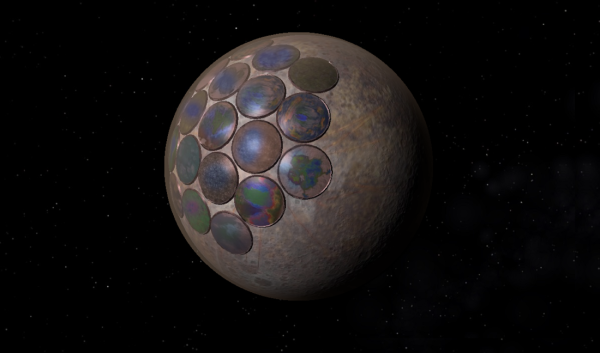 Image from Steve Bowers | |
| Reyvik has a thin atmosphere but supports many large domed habitats, most of which contain experimental environments engineered by the Zoeific Biopolity. | |
Name meaning: Reyvik means 'Dust Ocean' in the local language.
Colonised: 1022 by descendants of The Maid.
Reyvik's early history was not particularly notable, and the only event of significance is that it became an autonomous part of the Rasante polity in 2771. Throughout the Taurus Nexus era, it remained an underdeveloped, unimportant world, which meant Reyvik was not as badly damaged as most other participants during the First Resonantine War. During the brief system-wide dark age that followed the Fallapart, the planet's leadership took the chance to expand its influence in the absence of competitors. It was successful, and the planet supplanted Visne, its former parent polity, as a major system power. In 5257, after the fall of the ComEmp, it introduced its own version of the ontology. The schism between its supporters and its opposition culminated in the post-ComEmp tension period. Since the Iota Network uses the ComEmp ontology, Reyvik was among the last and the most reluctant in Seven Marbles to join it.
Reyvik has been, since the ComEmp era, moderately bioist, due to influences from the Zoeific Biopolity. After joining the Seven Marbles Combine, several large domes known as 'envirozones' have been constructed on Reyvik's sunward side, protected by active filters from the constant insolation. Specially designed, novel ecosystems including aesthetically-designed floras and faunas, biological marine habitats and colourful desert biomes have been developed on this world. At first these envirozones were uninhabited by modosophonts, apart from various envirovec morphs. However several envirozones now hold populations of sophonts who have been engineered to thrive in those locations without causing any significant ecological impact.
See this article for more details about the world Reyvik, and its physical characteristics before colonisation.
Remi (TRAPPIST-1e)
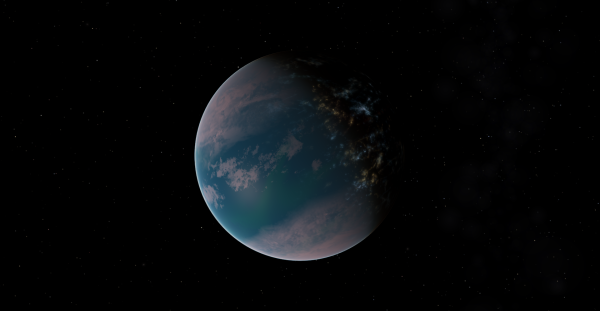 Image from The Astronomer | |
| Remi in the Current Era has a relatively standard Earth-like environment on the daylit side. | |
Name: This world was originally named Fulno by the descendants of The Maid. This world has been partially terraformed, and now supports an Earth-like environment, especially on the Dayside.
Name meaning: Fulno, the original name, referred to the strong winds. In 2185 the world was renamed Remi, which literally means 'Daynight'. This name is derived from the yin-yang symbol used by the new Union to symbolize the contrast and unity of dayside and nightside.
Colonised: 1212 by descendants of The Maid.
Remi has a relatively dense atmosphere, which freely flows from the day side to the nightside. Originally the atmosphere was anoxic, but the temperature range on the Dayside was temperate by Earth standards. Cloud patterns on this world were distinctive and dramatic, but the winds were somewhat too vigorous to be comfortable in some locations, so the planet was subject to an increasingly sophisticated program of modification. The planet was colonised by two groups, which evolved into two polities: the eusocial Day and the individualistic Night. At first, the relationship between the two was intense, but with help from other polities, shooting wars were averted. The two later united into the ideologically centrist Day-Night Union in 2185. The Union collapsed during the Resonantine War, but due to the chaos from the Fallapart, the power vacuum was only filled two hundred years later by descendants of the Maids.
During the ComEmp period, dozens of developer groups expressed their interest to obtain the terraformation rights of the planet; the Maids encouraged these groups to work together, and using a variety of techniques including Weather Machines, Sunshapers and biotech replicators, the world has a mildly temperate Earth-like climate on the daylight side, and a cool sub-zero environment on most of the darkside.
Remi, currently the third most populous planet in Seven Marbles, has a great cultural diversity with a myriad of factions. Representative cultures from every other world and habitat in the Resonance system and beyond may be found here, encouraged by the planet's own S2 transapient overseer, Maria. The interactions between these societies caused them to change rapidly, and relationships in this dynamic, intricately woven civilization are skillfully regulated by Maria, one of the seven hyperturings in charge of the civilizations on the seven planets in the Current Era.
See this article for more details about the world Fulno/Remi, and its physical characteristics before colonisation.
Shinoh (TRAPPIST-1f)
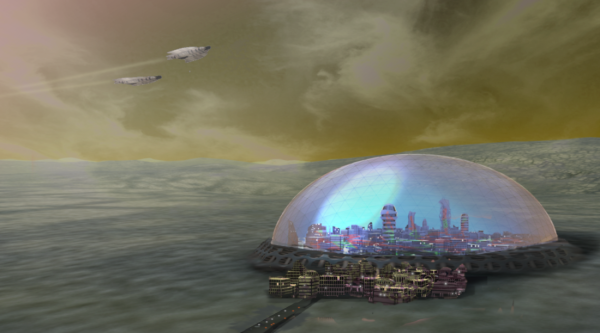 Image from Steve Bowers | |
| A Dome City on Shinoh (originally named Eunna by the first colonists). This planet retains its original anoxic atmosphere, and sophonts who require oxygen must either remain inside the domes or wear appropriate envirosuits. | |
Originally named Eunna.
Names: TRAPPIST-1f (T-1f), Eunna, Shinoh, Shinoh-Ulana
Name meaning: Renamed by the Eunna settlers during the ComEmp era, Shinoh is a contracted form of Shidoh-Ulanah, which means 'New Ulanah' in the Yosunoh language.
Colonised: 1061 by descendants of The Maid.
Eunna grew into a major power in the system during the Taurus Nexus era, controlling many off-world territories and building many extensive partnerships with other Taurus Nexus worlds. After the end of the First Consolidation War, it sought partnership with various Houses of Seven Marbles and Iota, which was by that time affiliated with the NoCoZo. The planet has a relatively dense atmosphere, with water oceans but very little free oxygen. Over the next thousand years this environment was populated with an entirely novel anaerobic biosphere teeming with neogenic lifeforms. A significant fraction of the population inhabit domed habitats supporting an oxygenated atmosphere; but most of the others are modified in various ways to thrive in the azotic atmosphere of this world, or wear sophisticated envirosuits when moving from one environment to another.
As a collectivist, conformist polity, the planetary polity was among the first to trade blows with the individualists. Having to weather Visne's extensive use of nanoplague attacks, its immunity systems were in shambles by the time the Fallapart disaster struck, and what little remains of its nanodefense was not enough to ward off the nanoswarms. In the end, 68% of the planet's population, as well as its entire neogen biosphere, were annihilated by 4570. Eunna was later resettled by virtual settlers from Yosunoh during the ComEmp era, at which time the planet was renamed Shinoh. Shortly after, the population boom occurred, leading to the creation of vast banks of computronium in the deep ocean. The embodied population, mostly Euannan refugees who returned, live in newly constructed domes, and on floating atolls grown by a new iteration of the original biosphere.
Despite containing several trillion virtual sophonts, Shinoh culture in the cybercosm is unusually uniform and conformist. It was heavily influenced by Eunoh Aiduh of Yosunoh, although cultural drift, influence from other Seven Marbles polities, and the Iota Scholar, gradually transformed it into its own version. The embodied population, numbering less than a hundred million, steadfastly hold onto the Eunnan tradition, or their idealized version of it. The debates about these idealized versions have continued into the Current Era, and have long since turned into a form of entertainment.
See this article for more details about the world Eunna/Shinoh, and its physical characteristics before colonisation.
Nene (TRAPPIST-1g)
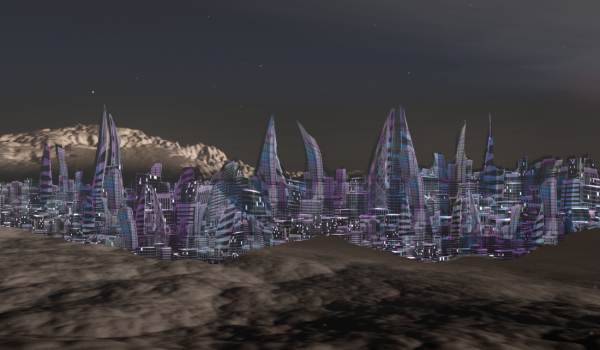 Image from Steve Bowers | |
| The cities on Matow (later called Nene) were grown using biomimetic replicator technology; unfortunately the city growth produced a riotous chaos of habitable city-scape, which was mostly empty at first, then slowly became populated over the following millenia. | |
Originally known as Matow.
Names: TRAPPIST-1g (T-1g), Matow, Nene
Name meaning: Matow, the original name, meant 'glacier'. The new name was chosen by a referendum held during the ComEmp. The planet was renamed after an important local cultural hero, nicknamed 'Nene', a hivemind consisting of nearbaseline humans. Nene was commander of the Matow military who successfully repelled several waves of Yaudel attackers.
Colonised: 1693, during the Federation Era.
Nene, originally known as Matow, was colonised by a breakaway faction of Maids, who used replication technology to construct habitats on and below the surface. In 2714 these replicating systems spontaneously began to create a complex, chaotic urban jungle, which covered much of the surface in (largely unpopulated) living space.
Now having ample room available for incomers, Matow welcomed many factions, from the Taurus Nexus and beyond, with open arms. The mix of often incompatible ideologies led to civil conflict during the First Consolidation War period, pitting various factions against each other. Matow did not join the Resonantine War, although as a collectivist world, it was attacked many times nonetheless. The planet was the destination of a large number of refugees from Shinoh after the 4790 technoswarm outbreaks. It was then attacked several times by Yaudel, driving the remaining population down into the safety of the subsurface ocean and opened the path for Reyvik's rise. The planet was a major proponent of the ComEmp ontology, even after the decline, putting it in conflict with Reyvik in the post-ComEmp tension period. Similar to Shinoh's late-ComEmp boom, Nene's population exploded in the 6200s, quickly filling up the reconstructed cities, which steadily expanded across the planet's crust and deep below.
Its Matowian-Ulanan hybrid culture has been heavily altered through its close relations with the recolonised Shinoh. Unlike Shinoh culture, however, embodied Nene societies are very ril-conscious. There is a tendency among the Nene people to extravagantly decorate their ril selves, possessions, and even their sceneries. The cities of Nene are thus almost always cladded in an arrangement of various sense stimuli that the consensus at the time finds aesthetically pleasing. The planet's poles sport many powerful natural geysers. They were often used as the planet's symbol. After modifications made during the early 7700s, they now blast water up to hundreds of meters from the surface.
See this article for more details about the world Matow/Nene, and its physical characteristics before colonisation.
Yaudel (TRAPPIST-1h)
Names: TRAPPIST-1h (T-1h), YaudelTransapient Overseer: Tianfei
Name meaning: Yaudel means 'edge' in Kunan, a cultural lingua franca used by a group of habitats in the Resonantine Belt.
Colonised: 1031 by descendants of The Maid.
In 2298 the Sekintorof Cyborgium, part of the Conver Ambi, established a polity on Yaudel, which came into conflict with the Rasante Power Authority during the First Resonantine War.
For millennia, Yaudel was home to a single, static, peaceful polity known as the Sanctuary, located in subsurface habitats in the relatively shallow ocean beneath the ice crust on the dayside. The Sanctuary was led by a S:1 tribemind also known as Sanctuary. In 4077, however, the entire population of the Sanctuary announced plans to transcend directly to S:3 status, a risky procedure which could have ended in failure or the creation of an unstable blight.
After heated debate between Sanctuary and the other factions in the system this attempt was abandoned, but relationships between this entity and the other polities remained strained. Yaudel withdrew from contact with the rest of the system, and became isolated; as a result of this, Yaudel was largely untouched by the Second Resonantine War.
After the war, undamaged Yaudel was in a strong position, and began to send military expeditions to the other worlds and habitats, ostensibly to offer aid, but more importantly to increase their influence among the recovering economies. This aggressive expansionism was opposed by an alliance led by the Samsara Focus, and eventually halted.
Yaudel's relations with other worlds improved after the ComEmp, with the arrival of a new S:1 known as Tianfei. In 7866, a number of computronium nodes were constructed on Yaudel's seafloor, using the ocean as a heat sink; these nodes host a diverse range of virchworlds. A sizable portion of this planet's population migrated into these virches, and became closely aligned with the Cyberian Network. In contrast Yaudel's cool surface has closer ties with Metasoft and is now home to a number of cryovec and marine vec communities, both in the ice and below it, in the ocean itself.
Suspended beneath the ice crust are a number of aquatic habitats aligned with the Fomalhaut Acquisition Society, and there the ancient Sanctuary cultures are studied and reconstructed in suitably modified form.
See this article for more details about the world Yaudel, and its physical characteristics before colonisation.
The Resonantine Belt
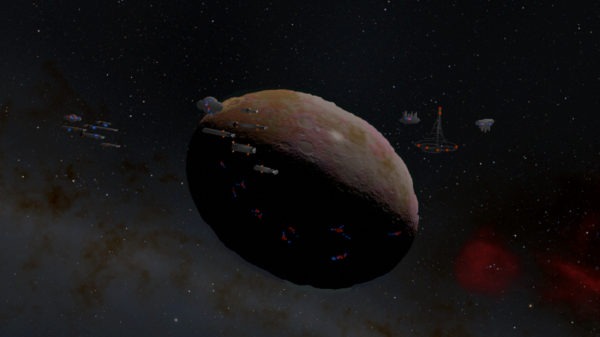 Image from Steve Bowers | |
| Samsara, a Haumea-type planetoid with extensive shipyards, is the home to the Maids and retains the tombs of many of the first colonists. | |
Definition: An asteroid belt stretching from Yaudel's orbit to the relatively sparse Oort cloud.
Total mass: 4.727E20 kg. Samsara has an average radius of just under 2000km.
Colonised: 876, by The Maid, which started to replicate eir mindstate into a range of different forms, populating the large planetoid Samsara first.
The Resonantine Belt has a long history; safe from the damaging flares of the red dwarf star, it was settled long before the inner planets, and due to its sheer size and diversity, it has never developed a unified government. Although these predominantly virtual societies had little interest in the ril and generally avoided the diplomatic see-saw the inner system experienced in the early millennia, the Resonantine belt polities, some of which had defense pacts with the inner system powers, were inevitably dragged into the Resonantine War. Their involvement proved to be disastrous for both sides, although it ultimately yielded little benefit due to the subsequent Fallapart, which virtually rendered victory moot. The isolation strategy worked wonders for these scattered polities to wait out the dark age, and again during the post-ComEmp tension period.
Currently, the Belt contains 28 administration divisions, each with its own cultural theme retained from their independent polity predecessors. All these divisions, like every other polity in Seven Marbles, are part of the Seven Marbles Combine.
The largest planetoid, Samsara, a Haumea-type dwarf planet, is home to the Samsara Focus where the Maids originated. Derived from the sophont ship that first arrived in this system, the Maids take many forms - sometimes spacecraft, sometimes moravec robots with a wide range of forms, sometimes aioids or infomorphs, and sometimes adopting humanoid bodies or those of other modosophont clades.
Although their golden age was basically over by the first thousand years since arrival, their legacy persists to this day. Using skillful diplomacy combined with the sheer distance from the rest of the system, the Maids successfully navigated through the system's chaotic times largely unscathed. It is also central to the peacekeeping and philanthropic efforts within the Seven Marbles system. The world made its name outside Seven Marbles during the ComEmp era, when it expanded its field of operation out to many other systems, and again during the Central Alliance era, when its peacekeeper forces worked to help various systems affected by the chaotic events during that period.
In the Current Era, Samsara is but one of the many polities which comprise the Seven Marbles. Its population consists mainly of aioids and vecs, and the 'pure' Maids have become a minority, yet still famous for their history and heritage. Samsara is the final resting place of the original spacecraft Maid's human colonists, preserved in nanostasis for the foreseeable future.
Travel
Wormhole
A Short Walk (1,600 m) to Lucida (system containing Corona).Beamrider Routes
Currently routes exist to HIP 112774 and Ain Soph Aur (Delta Capricorni), amongst other more infrequent destinations.Related Articles
Appears in Topics
Development Notes
Text by The Astronomer
Additional material by Steve Bowers
Initially published on 15 December 2023.
Developed by Steve Bowers from a detailed timeline by The Astronomer.
Additional material by Steve Bowers
Initially published on 15 December 2023.
Developed by Steve Bowers from a detailed timeline by The Astronomer.






